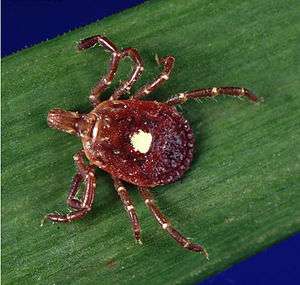Trombicula
| Trombicula | |
|---|---|
 | |
| Larval harvest mite from North America | |
| Scientific classification | |
| Kingdom: | Animalia |
| Phylum: | Arthropoda |
| Class: | Arachnida |
| Subclass: | Acari |
| Order: | Trombidiformes |
| Family: | Trombiculidae |
| Genus: | Trombicula Berlese, 1905 |
Trombicula is a genus of harvest mites (also known as red bugs, scrub-itch mites, berry bugs, or in their larval stage, as chiggers or chigoe) in the Trombiculidae family. In their larval stage, they attach to various animals, including humans, and feed on skin, often causing itching. These relatives of ticks are nearly microscopic, measuring 0.4 mm (0.01 in) and have a chrome-orange hue. A common species of harvest mite in North America is Trombicula alfreddugesi; in the UK, the most prevalent harvest mite is Trombicula autumnalis.
The larval mites feed on the skin cells, but not blood, of animals. The six-legged parasitic larva feeds on a large variety of creatures, including humans, rabbits, toads, box turtles, quail, and even some insects. After crawling onto their hosts, they inject digestive enzymes into the skin that break down skin cells. They do not actually "bite", but instead form a hole in the skin called a stylostome, and chew up tiny parts of the inner skin, thus causing severe irritation and swelling. The severe itching is accompanied by red pimple-like bumps (papules) or hives and skin rash or lesions on a sun-exposed area. For humans, itching usually occurs after the larvae detach from the skin.
After feeding on their hosts, the larvae drop to the ground and become nymphs, then mature into adults, which have eight legs and are harmless to humans. In the postlarval stage, they are not parasitic and feed on plant materials. The females lay three to eight eggs in a clutch, usually on a leaf or under the roots of a plant, and die by autumn.
Range
Harvest mites are found throughout the world. In Europe and North America, they tend to be more prevalent in the hot and humid parts. In the more temperate regions, they are found only in the summer (in French, harvest mites are called aoûtat, after août, August; vendangeon, after vendange, harvest; or rouget, after rouge, red). In the United States, they are found mostly in the southeast, the south, and the Midwest. They are not present, or barely found, in far northern areas, high mountains, or deserts. They live in forests and grasslands, and are also found in low, damp areas where vegetation is rank, such as woodlands, berry patches, orchards, along lakes and streams, and even in drier places where vegetation is low, such as lawns, golf courses, and parks. They are most numerous in early summer, when grass, weeds, and other vegetation are heaviest. Harvest mites can also find their way into homes, and onto human hosts, on decorative Spanish moss.
Taxonomy
The genus Trombicula has 16 species recorded from North America:
- Trombicula acuitlapanensis (A. Hoffmann, 1957)
- Trombicula alfreddugesi
- Trombicula autumnalis (Shaw)
- Trombicula boneti (A. Hoffmann, 1952)
- Trombicula formicarum (Berlese, 1910)
- Trombicula geniticula
- Trombicula halidasys
- Trombicula imperfecta (Brennan & Jones, 1954)
- Trombicula jamesoni (J. M. Brennan, 1948)
- Trombicula jonesae (J. M. Brennan, 1952)
- Trombicula nagayoi
- Trombicula patrizii (Valle, 1952)
- Trombicula pumilis
- Trombicula spinosa
- Trombicula tecta
- Trombicula zeta
Other species include Trombicula batatas and Trombicula hirsti.
See also
- Chigger bite
- Mite
- Trombiculidae
- Chigoe flea Tunga penetrans
References
- The World Book Encyclopedia, 2000 ed.
- Encyclopædia Britannica, 2005 ed. Accessed with paid subscription.
- Todd Ballantine (1991). Tideland treasure: the naturalist's guide to the beaches and salt marshes of Hilton Head Island and the southeastern coast. Columbia, S.C: University of South Carolina Press. ISBN 0-87249-795-X.
- Green, Sherri Deatherage (June–July 2005). "Give Chiggers The Brush". Mother Earth News (210): 93–8.
External links
| Wikisource has the text of the 1911 Encyclopædia Britannica article Harvest-bug. |
- "Chiggers!" at Missouri Department of Conservation
- Chiggers at Pestproducts.com
- Iowa State University Department of Entomology Insect Information Note
- NIH Medline Plus
- Ohio State University Extension Fact Sheet, Entomology, Chiggers, HYG-2100-98
- Trombicula autmunalis
